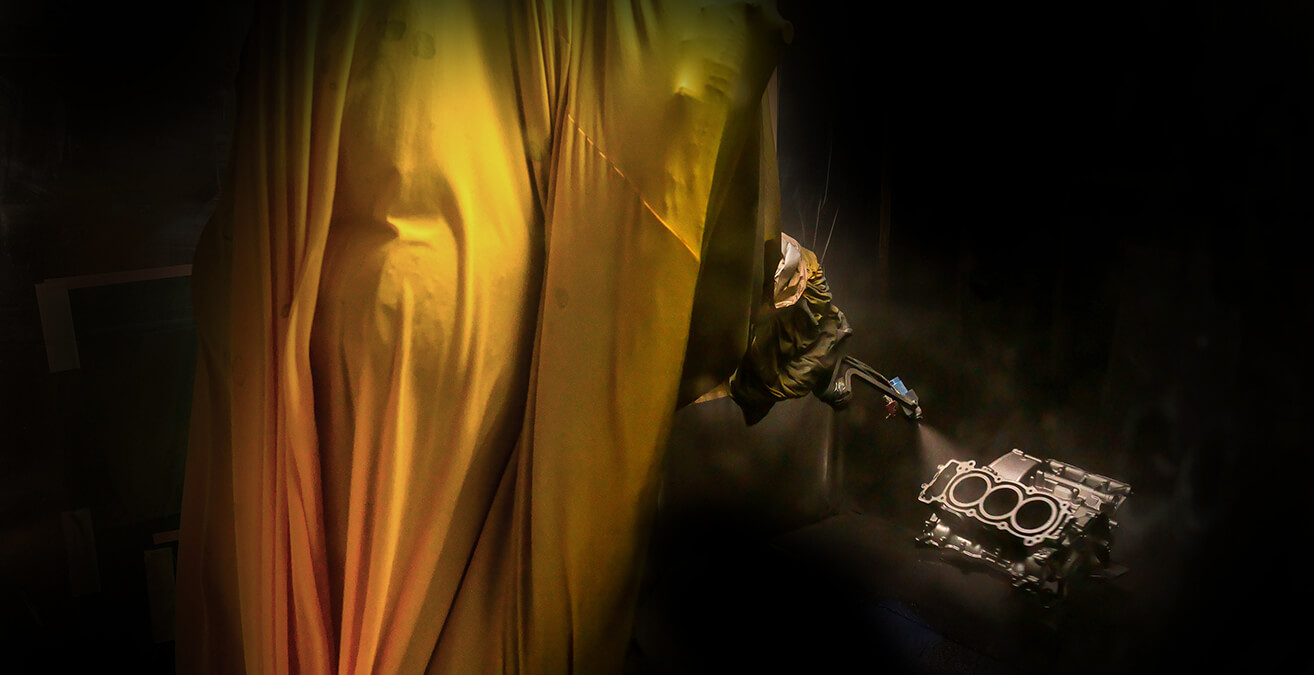The Engine Coating Line: Where People and Robots Have “Mutual” Respect
The MT-09’s 3-cylinder engine features all-new designs for nearly all of its main components, from the pistons and connecting rods to the crankshaft. This new, compact powerplant is the heart of the bike’s signature agility, and its exterior finish in the newly created Crystal Graphite color makes it stunning to the eye as well.
The color was meant to create a sheen heavily emphasizing the metal’s innate qualities, with the semi-gloss finish making the engine’s various surface treatments appear even more beautiful. It is the first new engine color from Yamaha’s engine paint shop in years, and the result of a harmonious collaboration and sharing of specialties between human hands and robot arms.
The Fine Strokes of the Craftsmen of Colors
After its pre-treatment work is carefully completed, the MT-09’s 3-cylinder engine is fed through to the painting line with its aluminum body completely exposed. About an hour after being sent off, the engine returns to its starting point, now dressed in a coat of beautiful Crystal Graphite paint.
As the units make their trip down the painting line like a row of recruits, no human hands will touch them. A black box mounted above the line controls robotic arms that apply the coating with the delicate movements of a master, and the baking, drying and cooling processes that follow have all been automated.
The engine painting line at the Iwata Main Factory was completed in 2015 and brought various innovations to the matte black painting process; everything from pre-treatment to the application of the final coating was meticulously reviewed and revised.
The new line that was built occupies just one-third the space of the previous arrangement, and the number of processes needed were reduced by nearly 75%. The driver of these dramatic improvements was to program robots to learn the skills of our master craftsmen. This enables the robots to perform the high-quality work of their teachers over and over, accounting accordingly for difficulty and detail with each high-speed repetition. The fine control of the spray pressure, volume of paint, distance and angle of the spray nozzles, and nimble movements of the robot arms faithfully mimic the hard-won skills of the master craftsmen that “taught” them.

Human Hands and Robot Arms: A Complementary Line
In one corner of the paint shop is a white room. Although white walls are rarely seen in factory paint shops, the environment the walls create speak of the delicate work being done by hand inside. This room is where the pigment to create the Crystal Graphite color sprayed onto the engine by the robots is prepared and supplied.
The temperature and humidity in this room, where the pigments and organic solvents are blended, is carefully controlled. One might think that a comparatively simpler step like this is what should be automated—but no. Humans are blessed with keen senses that notice things that hard numbers cannot reveal, and this level of tactile and visual skill takes years of experience to acquire.
“Well, take the humidity for example,” says one technician. “The indicator reads 55%, but there can be a lot of things behind that 55%. The same goes for temperature. If you rely solely on the numbers, you can’t produce consistent, high-quality pigment.” The technician slowly stirs an 18-liter can of paint with a large wooden spatula. The scene is reminiscent of a toji master sake brewer stirring a vat of fermenting rice to produce their best bottle, and for a split-second, it all feels almost primitive in nature.
With each stirring motion of the technician’s wrist, the metallic fluid glitters in the light. In silent immobility, the painting robots await its completion. “This is one step we can’t leave to the robots. They could probably produce something close to a Crystal Graphite pigment, but not the real thing.” The robots depend on humans and the humans depend on the robots in a relationship based on a “mutual” respect of the other’s specialties.

A Presence Conveying Quality and Performance
The paint applied to an engine is subjected to a vastly harsher environment than paint for frames. It must never come off and also retain its luster even after endless hours of exposure to the high temperatures generated by the engine, and since the engine is oft-considered the heart of a motorcycle, its appearance must also visually express the machine’s quality and performance. In a word, it requires a striking presence in both the garage and in the sunlight.
After completing its one-hour trip down the line, the CP3 engine has a look and feel emblematic of the metal itself and must now pass a stringent, multi-step, multi-person visual inspection before being deemed acceptable. By the numbers, even one out of several hundred engines is a rarity, but any flaw in the paint sprayed by the robots does not escape this final inspection performed by human eyes.
The painted finishes for engines are much fewer in variation than the colors used for bodywork. However, the introduction of just one new color is incredibly labor-intensive, and the MT-09’s Crystal Graphite is the first one in years, bringing a standout, incredibly metallic sheen to the all-new 890cc powerplant.








